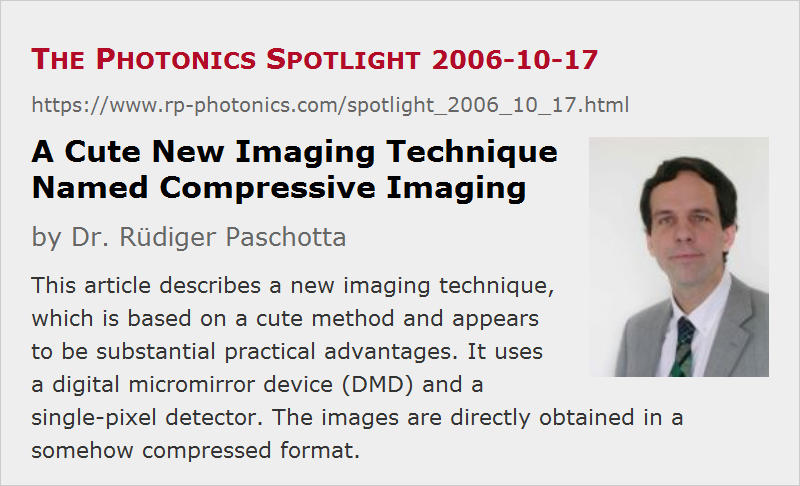A Cute New Imaging Technique Named Compressive Imaging
Posted on 2006-10-17 as a part of the Photonics Spotlight (available as e-mail newsletter!)
Permanent link: https://www.rp-photonics.com/spotlight_2006_10_17.html
Author: Dr. Rüdiger Paschotta, RP Photonics Consulting GmbH
Abstract: This article describes a new imaging technique, which is based on a cute method and appears to be substantial practical advantages. It uses a digital micromirror device (DMD) and a single-pixel detector. The images are directly obtained in a somehow compressed format.

The latest Physics News Update (see the reference above) points to very interesting new research on a new imaging technique, suitable e.g. for remote cameras. Here, light from an object is reflected from a digital micromirror device (DMD), and part of the reflected light hits a single photodiode or other photodetector. The measured light intensity is now recorded for thousands of different pseudorandom binary patterns of the micromirrors, where each mirror either reflects light or is an “off” position. A computer can later reconstruct an image from these data. Anyone being familiar with Fourier optics may immediately have at least some vague idea how that might work, but I won't try to explain this here.
The method doesn't only look cute, it is also potentially very useful. First of all, it requires only a single-pixel detector, which enormously expands the range of usable photodetectors. Second, it requires fairly little memory in the device; several thousand bytes are enough for images which hundreds of thousands of pixels, since the image information is automatically obtained in a somehow compressed form. This compression also facilitates data transmission e.g. with a wireless connection. The computational burden for reconstructing the image may not be a severe problem, since this job can be done offline. The camera itself can be very simple. Overall, the method could be very efficient compared to the traditional way of recording a full image, compressing it locally with corresponding hardware and software in the camera (using e.g. a JPEG algorithm), sending it, and decompressing it again in the computer.
This article is a posting of the Photonics Spotlight, authored by Dr. Rüdiger Paschotta. You may link to this page and cite it, because its location is permanent. See also the RP Photonics Encyclopedia.
Note that you can also receive the articles in the form of a newsletter or with an RSS feed.
Questions and Comments from Users
Here you can submit questions and comments. As far as they get accepted by the author, they will appear above this paragraph together with the author’s answer. The author will decide on acceptance based on certain criteria. Essentially, the issue must be of sufficiently broad interest.
Please do not enter personal data here; we would otherwise delete it soon. (See also our privacy declaration.) If you wish to receive personal feedback or consultancy from the author, please contact him e.g. via e-mail.
By submitting the information, you give your consent to the potential publication of your inputs on our website according to our rules. (If you later retract your consent, we will delete those inputs.) As your inputs are first reviewed by the author, they may be published with some delay.
 |




If you like this page, please share the link with your friends and colleagues, e.g. via social media:
These sharing buttons are implemented in a privacy-friendly way!